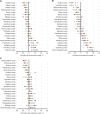Regional variations in excessive polypharmacy and potentially inappropriate drug use among older adults in Sweden: Trends from 2006 to 2020
- PMID: 36843915
- PMCID: PMC9945538
- DOI: 10.3389/fphar.2023.1030849
Regional variations in excessive polypharmacy and potentially inappropriate drug use among older adults in Sweden: Trends from 2006 to 2020
Abstract
Introduction: Potentially inappropriate drug use (PID) is common among older adults. Cross-sectional data suggest that there are marked regional variations in PID in Sweden. There is, however, a lack of knowledge about how the regional variations have changed over time. Objectives: This study aimed to investigate the regional differences in the prevalence of PID in Sweden, 2006-2020. Methods: In this repeated cross-sectional study, we included all older adults (≥75 years) registered in Sweden, yearly from 2006 to 2020. We used nationwide data from the Swedish Prescribed Drug Register linked at the individual level to the Swedish Total Population Register. We selected three indicators of PID according to the Swedish national "Quality indicators for good drug therapy in the elderly": 1) Excessive polypharmacy (use of ≥10 drugs); 2) Concurrent use of three or more psychotropic drugs; 3) Use of "drugs that should be avoided in older adults unless specific reasons exist." The prevalence of these indicators was calculated for each of Sweden's 21 regions, yearly from 2006 to 2020. The annual coefficient of variation (CV) was calculated for each indicator by dividing the standard deviation of the regions by the national average, to measure relative variability. Results: In the population of about 800,000 older adults per year, the national prevalence of "drugs that should be avoided in older adults," was reduced by 59% from 2006 to 2020. There was a slight decline in the use of three or more psychotropics, while the prevalence of excessive polypharmacy increased. The CV for excessive polypharmacy was 14% in 2006 and 9% in 2020 compared to 18% and 14% for "use of three or more psychotropics", and stable at around 10% for 'drugs that should be avoided in older adults.' Conclusions: The regional variation in potentially inappropriate drug use decreased or were stable from 2006 to 2020. The regional differences were largest for the use of three or more psychotropics. We found a general tendency that regions with a good performance at the start of the period performed well across the entire period. Future studies should investigate the reasons for regional variation and explore strategies to reduce unwarranted differences.
Keywords: aged; ageing population; inappropriate drug use; polypharmacy source: MeSH; regional variability; scoping; trends (source: MeSH NLM).
Copyright © 2023 Wastesson, Fritzell, Burström, Johnell and Fastbom.
Conflict of interest statement
The authors declare that the research was conducted in the absence of any commercial or financial relationships that could be construed as a potential conflict of interest.
Figures


Similar articles
-
Trends in inappropriate drug therapy prescription in the elderly in Sweden from 2006 to 2013: assessment using national indicators.Drugs Aging. 2014 May;31(5):379-86. doi: 10.1007/s40266-014-0165-5. Drugs Aging. 2014. PMID: 24687310 Free PMC article.
-
The influence of educational level on polypharmacy and inappropriate drug use: a register-based study of more than 600,000 older people.J Am Geriatr Soc. 2009 Jan;57(1):62-9. doi: 10.1111/j.1532-5415.2008.02040.x. Epub 2008 Nov 14. J Am Geriatr Soc. 2009. PMID: 19054196
-
To what extent does the indicator "concurrent use of three or more psychotropic drugs" capture use of potentially inappropriate psychotropics among the elderly?Eur J Clin Pharmacol. 2009 Jun;65(6):635-42. doi: 10.1007/s00228-009-0623-x. Epub 2009 Feb 12. Eur J Clin Pharmacol. 2009. PMID: 19219427
-
National indicators for quality of drug therapy in older persons: the Swedish experience from the first 10 years.Drugs Aging. 2015 Mar;32(3):189-99. doi: 10.1007/s40266-015-0242-4. Drugs Aging. 2015. PMID: 25673123 Free PMC article. Review.
-
Medication use in older patients and age-blind approach: narrative literature review (insufficient evidence on the efficacy and safety of drugs in older age, frequent use of PIMs and polypharmacy, and underuse of highly beneficial nonpharmacological strategies).Eur J Clin Pharmacol. 2019 Apr;75(4):451-466. doi: 10.1007/s00228-018-2603-5. Epub 2019 Jan 4. Eur J Clin Pharmacol. 2019. PMID: 30610276 Review.
Cited by
-
Pre-clinical Models for Geriatric Pharmacotherapy.Drugs Aging. 2024 Aug;41(8):633-640. doi: 10.1007/s40266-024-01129-6. Epub 2024 Jul 9. Drugs Aging. 2024. PMID: 38982010 Free PMC article. Review.
-
Reliability and validity of the Swedish indicator 'Drugs that should be avoided in older people'-an appraisal of a set of potentially inappropriate medications.Eur J Clin Pharmacol. 2024 Sep;80(9):1285-1293. doi: 10.1007/s00228-024-03700-x. Epub 2024 May 14. Eur J Clin Pharmacol. 2024. PMID: 38743072 Free PMC article.
-
Associations between specialized dementia care, COVID-19 and central nervous system medication use in assisted living: a population-based repeated cross-sectional study.BMC Geriatr. 2024 Aug 14;24(1):684. doi: 10.1186/s12877-024-05274-w. BMC Geriatr. 2024. PMID: 39143530 Free PMC article.
References
-
- Eriksen J., Gustafsson L. L., Ateva K., Bastholm-Rahmner P., Ovesjö M-L., Jirlow M., et al. (2017). High adherence to the “wise list” treatment recommendations in Stockholm: A 15-year retrospective review of a multifaceted approach promoting rational use of medicines. BMJ Open 7, e014345. 10.1136/bmjopen-2016-014345 - DOI - PMC - PubMed
LinkOut - more resources
Full Text Sources

